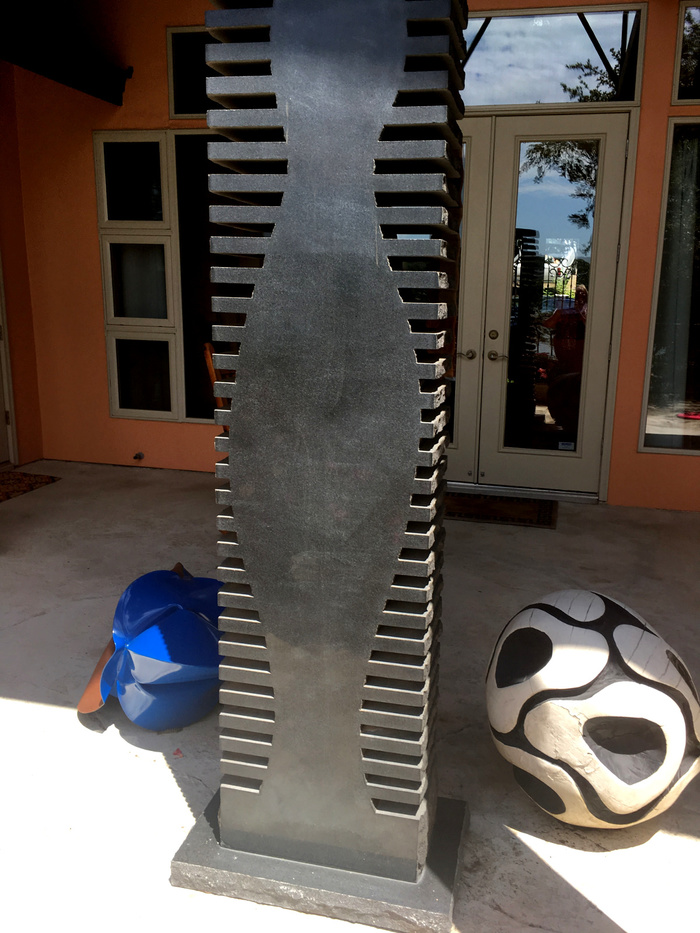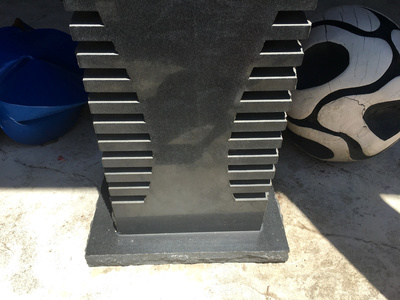Jesus Moroles "Figure Las Mesas"
-
- Jesus Moroles
- (1950-2015)
- Rockport Artist
- Image Size: 80" x 20" x 12"
- Medium: Black Granite Sculpture
- 2003
- "Figure Las Mesas"
- Contact for Price & Info
- View All By This Artist
Details
This was a commissioned piece. It is extremely heavy. We have the original invoices and basic sketch for this piece. It is in excellent condition but is very dusty and dirty. It will need to be washed with soap and water.
Mid Century Modern -
Biography
Jesus Moroles (1950-2015)
Following is the obituary of Jesus Moroles from mySA, San Antonio Express News
Renowned Texas sculptor Jesús Moroles died in a vehicle crash late Monday night. He was 64.
Moroles, who was born in Corpus Christi in 1950 and lived and worked in Rockport, was driving on Interstate 35 when he was involved in a crash north of Georgetown, according to the Rockport Pilot, which spoke to the artist’s sister Susanna Moroles. Other details were unavailable.
A representative of Moroles’ gallery, Arthur Roger Gallery in New Orleans, confirmed the report.
“He was going to be our featured artist in August,” said gallery director Bradley Sabin. “Now it’s totally up in the air.”
Moroles created both monumental and smaller scale works in granite. He received the 2008 National Medal of Arts and was the 2011 Texas State Artist for three-dimensional work.
“I knew Jesús for many years,” said San Antonio sculptor Bill Fitzgibbons. “I always found him very generous of spirit and supportive of other sculptors. He was one of a kind, and I will greatly miss his friendship.
“In terms of granite, I don’t know anybody who could sculpt and create pieces out of that material the way that Jesús could,” Fitzgibbons added. “I would say that he was not only one of the best sculptors in Texas, but in the United States.”
Moroles has a public piece at the Southwest School of Art, as well as “River Stelae,” a sculpture consisting of three monumental slabs of granite near the San Antonio Museum of Art.
“Working with Jesus on the sculptural fountain of Texas pink granite that graces our historic campus was a remarkable experience for me because of his personal warmth, wit and passion,” said Paula Owen, president of the Southwest School of Art. “And it was incredible to visit his studio and workshop in Rockport where he created major pieces for locations around the world. Texas has lost a significant artist, and I mourn his passing.”
Moroles once said of his sculpture: “My work is a discussion of how man exists in nature and touches nature and uses nature. Each of my pieces has about 50 percent of its surfaces untouched and raw — those are parts of the stone that were torn. The rest of the work is smoothed and polished. The effect, which I want people to not only look at but touch, is a harmonious coexistence of the two.”
According to the Rockport Pilot, the artist was at home last week finalizing transport of a sculpture to Dallas. He and his crew made the delivery Thursday and assembled the sculpture for the downtown Dallas area.
Susanna Moroles told the paper that her brother returned to Rockport from Dallas on Sunday because he had a jury duty notice for Monday. Then he then left town Monday evening, heading north to Oklahoma, to begin work on his next commissioned piece.
Courtesy of Shari MorrisonWell known for his monumental granite sculpture, Jesus Moroles has one of his works in the White House sculpture garden. A 64 ton piece is also across from the Museum of Modern Art in New York City. He works, not by carving granite, but by hammering 5-inch steel wedges into large slabs, causing them to split against the grain. He polishes some surfaces and leaves others raw.
He apprenticed with Luis Jimenez, who tried to persuade him unsuccessfully to work in fiberglass that looked like stone. But he wouldn't do it because he likes "living stone" that resists his efforts. Moroles first encountered granite in 1978 on the eve of his graduation from the University of North Texas in Denton. And his first piece of granite sculpture sold at the Shidoni Outdoor Sculpture Show in Tesuque, New Mexico, which of course gave him much encouragement.
For the last 20 years, beginning in the 1980s, Moroles, born and raised in the inner city of Dallas, has based his studio in Rockport, Texas, about 35 miles north of Corpus Christi. It is a sleepy, fishing village but is also headquarters to Moroles, Inc., a multi-million dollar business that employs about 20 people. His parents, Mexican immigrants, also live on the property as do the peacocks raised by his father. He travels widely including to Aswan, Egypt and Changchun, China where he has installed his sculpture.
Source: "Southwest Art", March 2001
Biography from Altermann Galleries and Auctioneers, IIBorn in Corpus Christi, Texas in 1950 and educated with a BFA at North Texas State University in Denton, Texas, Jesús Moroles lives and works in Rockport, Texas.
After returning from a year of studio work in Italy in 1980, Moroles commenced to make the body of work for which he is widely known. Critical recognition for Moroles came quickly with many of his early exhibitions at Texas museums.
In 1981, Moroles purchased his first large diamond saw, which began his long term commitment to create a studio. In 1983, Moroles began his construction in Rockport. The workings of the studio became a family effort with the artist involving his parents Jose and Maria, his brother, Hilario, his sister, Suzanna, and brother-in-law, Kurt Kangas as integral parts of the Moroles Studio. This facility is unequaled in the country for the making of large scale sculptures.
In 1982, Moroles received the Awards in the Visual Arts Fellowship for which his works were included in a two-year traveling museum exhibition which originated at the Museum of Contemporary Art in Chicago, Illinois.
During this period, Moroles began making large scale works such as his 22 foot tall sculpture fountain, titled Floating Mesa Fountain for the Albuquerque Museum in New Mexico. In 1985, Moroles received a National Endowment for the Arts Matching Grant for an environmental installation of 45 sculptural elements and fountains for the Birmingham Botanical Gardens in Birmingham, Alabama.
In 1987, Moroles completed his most visible work, Lapstrake, a 64 ton, 22 foot tall sculpture for the E.F. Hutton, CBS Plaza in New York City located across the street from the Museum of Modern Art. During this time he received significant national attention with his inclusion in the landmark museum exhibition, "Contemporary Hispanic Art in the United States." Originating from the Museum of Fine Arts in Houston, Texas, the exhibition traveled to the Corcoran Gallery of Art in Washington, D.C., the Museum of Fine Arts in Santa Fe, New Mexico, the Los Angeles County Museum of Art and the Brooklyn Museum.
Moroles' largest single work is the 1991 site sculpture, the Houston Police Officers Memorial. Comprised of granite and an earthen stepped pyramid surrounded by four equal inverted stepped pyramids excavated from the ground, the sculpture spans 120 feet by 120 feet.
Moroles established himself as one of the master sculptors of his generation with the recently completed (1996) "sculpture plaza" for the Edwin A. Ulrich Museum in Wichita, Kansas. In the tradition of his aesthetic mentor, Isamu Noguchi, Moroles designed and sculpted from granite, a Granite Landscape comprised of terraced slabs forming a stone riverway, a 30 foot long "Fountain Wall" and a 30 foot long "Granite Weaving" wall. Together, these works create a single environment that serves as an entrance to the museum and an outdoor site to exhibit important sculpture.
In the summer of 1996, Moroles celebrated the opening of his Moroles Cultural Center, an exhibition, performance, and studiospace located in the town of Cerillos, New Mexico (about 30 miles south of Santa Fe). To date, Moroles' work has been included in over 130 one-person exhibitions and over 200 group exhibitions. He has lectured extensively about his work and the issue of public sculpture. His work has been the subject of numerous articles and reviews in ARTNEWS, Arts, Artforum, Artspace, Artweek, Newsweek, Southwest Art, Time, and The New York Times as well as several books such as America Art Now, Art in the Eighties, National Museum of American Art, Contemporary Art in Texas, and Contemporary Art in New Mexico, and A Comprehensive Guide to Outdoor Sculpture in Texas.
Reference: From the Artist


